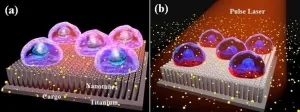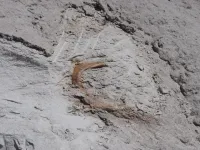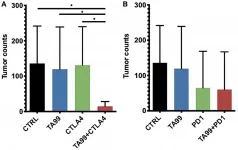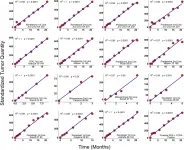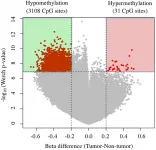Dramatic increase in microplastics in seagrass soil since the 1970s
2021-01-25
(Press-News.org) Large-scale production of vegetables and fruit in Spain with intensive plastic consumption in its greenhouse industry is believed to have leaked microplastic contaminants since the 1970s into the surrounding Mediterranean seagrass beds. This is shown in a new study where researchers have succeeded in tracing plastic pollution since the 1930s and 1940s by analyzing seagrass sediments.
About half of Sweden's cucumbers and a fifth of the tomatoes in Sweden are currently imported from Spain according to the Swedish Board of Agriculture. A special area in Spain where large-scale vegetable cultivation takes place is Almería on the Mediterranean coast in southeastern Spain. A new study from the area of Almería, also known as "the sea of plastic", shows that the intensive use of plastics in the greenhouse industry seems to have led to ever-increasing emissions of microplastics since the development of intensive greenhouse farming in the 1970s.
"Almería is unique in Europe because it is one of the few human structures that can be seen from space because it is so large. The area accounts for about a quarter, or three million tonnes, of the total Spanish exports of vegetables and fruit", says Martin Dahl, researcher in marine ecology at the Department of Ecology, Environment and Plant Sciences, Stockholm University, who is the first author of the study in the scientific journal Environmental Pollution.
The study was conducted by researchers from Stockholm University in collaboration with the Center for Advanced Studies of Blanes, the Spanish High Council for Scientific Research (CEAB-CSIC), the Swedish Environmental Research Institute (IVL) and Södertörn University.
Sediment storage can be used as historical environmental archives
Seagrass beds act as filters for coastal areas and can therefore capture particles, including microplastics, from land that get stuck on the leaves or end up in the sea bed. This makes seagrass beds interesting to study as they stabilize and build up thick sediment layers that can be used as historical environmental archives to, among other things, study the accumulation of microplastics over time.
The high concentrations of microplastics that have accumulated in the seagrass bed can potentially lead to the spread of microplastics to other environments or to animals:
"Seagrass beds could serve as a first step in the transfer of microplastics to animals, as many graze on seagrass or live in its sediment, and in this way could be exposed to plastic", says Martin Dahl.
Microplastics can also bind to heavy metals and other environmental toxins.
"We generally don't know enough about the effect of microplastics on the environment, but on the other hand we know that today plastic and microplastics occur almost everywhere in the oceans and therefore I think you should see it as a warning signal. Historically, there is usually a certain time lag from the introduction of environmental toxins until effects can be seen, such as with PCBs and DDT", says Martin Dahl.
The researchers found PVC and polystyrene
The high use of plastic in Almería is mainly due to the plastic films they use to cover the greenhouses. These wear out quickly and need to be replaced relatively often. Through usage and weathering of the plastic film and other types of plastic used in the production of vegetables and fruits, they end up in the environment and are passed on to the sea through runoff.
The researchers were able to find PVC and polystyrene used in greenhouse cultivation in Almería. However, the analysis could not identify all specific plastic polymers and link them directly to the type of plastic that the greenhouses are covered with.
The researchers have chosen to investigate the area on the coast outside Almería due to the fact that it has previously been known that greenhouse cultivation has a high consumption of plastic and that this might influence microplastic contaminants in the surrounding seagrass beds, which are known to capture particles that are transported with the water.
According to Martin Dahl, there are several ongoing research projects on microplastics in Sweden, especially at Kristineberg's marine research station outside Fiskebäckskil in western Sweden, but they have mainly looked at plastics in other types of bottoms and in the open sea, not in seagrass sediments.
"Studying microplastics in seagrass beds is very new and this is the first study, as far as I know, where dated seagrass sediments have been used to analyze the accumulation of microplastics over time, which makes the study very exciting", says Martin Dahl.
"There are still many questions about the effect of microplastics on seagrass ecosystems, but I hope that this study can draw attention to the problems that obviously exist around microplastic pollutants, not only in Almería but in the ocean in general", says Martin Dahl.
INFORMATION:
More information
The article "A temporal record of microplastic pollution in Mediterranean seagrass soils" is published in the scientific journal Environmental Pollution.
https://www.sciencedirect.com/science/article/pii/S0269749121000294
Contact
Martin Dahl, researcher at the Department of Ecology, Environment and Plant Sciences, Stockholm University.
46-70-433 61 12
martin.dahl@su.se
[Attachments] See images for this press release:
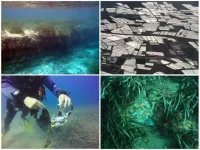
ELSE PRESS RELEASES FROM THIS DATE:
2021-01-25
Overview:
A research team at the Department of Mechanical Engineering at Toyohashi University of Technology developed a nanosecond pulse laser-assisted photoporation method using titanium-oxide nanotubes (TNTs) for highly efficient and low-cost intracellular delivery. The proof of concept for the possibility of intracellular delivery after irradiation with nanosecond pulse laser on TNTs was validated. TNTs were formed on titanium sheets using the electrochemical anodization technique at different voltages and times. HeLa - human cervical cancer cells were cultured in the nanotubes and submerged in a solution of biomolecules. After cells were exposed to nanosecond pulse laser, we successfully delivered ...
2021-01-25
There isn't much in Kamchatka, a remote peninsula in northeastern Russia just across the Bering Sea from Alaska, besides an impressive population of brown bears and the most explosive volcano in the world.
Kamchatka's Shiveluch volcano has had more than 40 violent eruptions over the last 10,000 years. The last gigantic blast occurred in 1964, creating a new crater and covering an area of nearly 100 square kilometers with pyroclastic flows. But Shiveluch is actually currently erupting, as it has been for over 20 years. So why would anyone risk venturing too close?
Researchers from Washington University in St. Louis, including Michael Krawczynski, assistant professor of earth and planetary sciences in Arts & Sciences and graduate student ...
2021-01-25
Abusive bosses may retain their positions by taking superficial steps to repair their social images following outbursts, without acting meaningfully to change their behaviors, according to research led by a University of Wyoming business management expert.
Shawn McClean, an assistant professor in UW's College of Business, joined colleagues from the University of Iowa, the University of Nebraska-Lincoln and Texas A&M University in conducting the research, which appears in the journal Personnel Psychology. Their study also was featured in Harvard Business Review, a preeminent business magazine.
"Our study shows that supervisors are often driven by simply repairing their social image rather than ...
2021-01-25
Male breast cancer patients were found to have a high prevalence of cardiovascular conditions, in a small study of this rare patient population presented at the American College of Cardiology's Advancing the Cardiovascular Care of the Oncology Patient Virtual course.
"Due to the rarity of male breast cancer, there is no cardiovascular data from larger clinical trials or population studies. The lack of large data makes it even more important to individualize cardiovascular assessment and management based on each patient's unique oncologic, therapeutic and pre-existing cardiovascular risk profile to support them through cancer treatment into survivorship," said Michael Ibrahim, fourth year ...
2021-01-25
PHILADELPHIA, PA - January 25, 2021 - Opertech Bio, Inc., today announced the publication of a seminal research article describing the application of its pioneering TāStation® technology to the pharmacological characterization of human taste discrimination. The findings are published in the peer-reviewed Journal of Pharmacology and Experimental Therapeutics, JPET.
The paper, entitled "Rapid throughput concentration-response analysis of human taste discrimination," is the first to quantitatively define the concentration-response function for human taste discrimination, a crucial step in understanding ...
2021-01-25
In a study of local rivers, experts at the University of Nottingham in the UK have discovered more invertebrates - animals without a backbone, such as insects and snails - living on litter than on rocks.
In urban rivers where there are no better alternatives, litter provided the largest, most stable and complex habitat available for invertebrates to live on.
The findings could have important implications for the management of urban rivers, including how river clean-up events are conducted.
The research team, in the School of Geography, studied three local rivers; the River Leen, Black Brook, and Saffron Brook, in ...
2021-01-25
DISCOVERY BRIEF:
The first new skull of a rare species of the dinosaur Parasaurolophus (recognized by the large hollow tube that grows on its head) discovered in 97 years.
Exquisite preservation of the new skull gives paleontologists their first opportunity to definitively identify how such a bizarre structure grew on this dinosaur.
For the first time, this study found characteristics to link tube-crested dinosaur species found in southern North America (New Mexico, Utah), distinct from the only northern species (Alberta).
The locality, in northwestern New Mexico, is dated to about 75 million years ago, a time when North America was divided by a shallow sea and teemed with duckbilled dinosaurs, horned dinosaurs and early tyrannosaurs.
Fossils from ...
2021-01-25
The cover for issue 2 of Oncotarget features Figure 4, "Combination therapy TA99/ICB reduced the lung tumor burden in the B16 model of metastases," published in "Improved therapeutic efficacy of unmodified anti-tumor antibodies by immune checkpoint blockade and kinase targeted therapy in mouse models of melanoma" by Pérez-Lorenzo, et al. which reported that here, the authors showed that removing immune suppression and enhancing stimulatory signals increased the anti-tumor activity of unmodified TA99 antibodies with a significant reduction of ...
2021-01-25
The cover for issue 1 of Oncotarget features Figure 2, "Results in clinical trials," published in "Drug resistant cells with very large proliferative potential grow exponentially in metastatic prostate cancer" by Blagoev, et al. which reported that most metastatic cancers develop drug resistance during treatment and continue to grow, driven by a subpopulation of cancer cells unresponsive to the therapy being administered.
There is evidence that metastases are formed by phenotypically plastic cancer cells with stem-cell-like properties.
Currently, the population structure and growth dynamics ...
2021-01-25
The cover for issue 52 of Oncotarget features Figure 1, "Volcano plots of DNA methylation in tumor tissues compared with nontumor tissue," published in "Reduction of T-Box 15 gene expression in tumor tissue is a prognostic biomarker for patients with hepatocellular carcinoma" by Morine, et al. which reported that the authors conducted a genome-wide analysis of DNA methylation of the tumor and non-tumor tissue of 15 patients with Hepatocellular carcinoma (HCC), and revealed TBX15 was the most hypermethylated gene of the tumor.
Another validation set, which comprised 58 HCC with radical resection, was analyzed to investigate the relationships between tumor phenotype and TBX15 mRNA expression.
TBX15 mRNA levels in tumor tissues were significantly lower compared ...
LAST 30 PRESS RELEASES:
[Press-News.org] Dramatic increase in microplastics in seagrass soil since the 1970s

